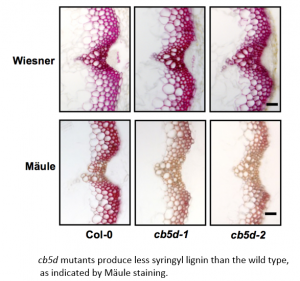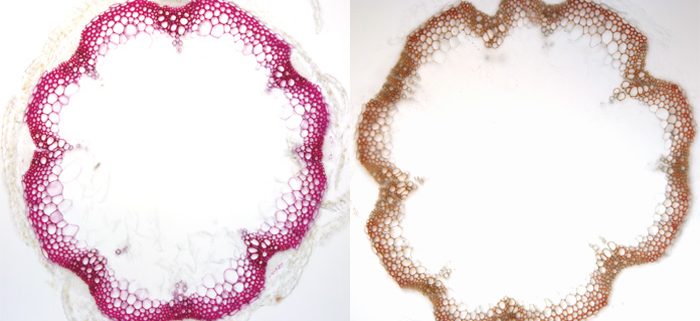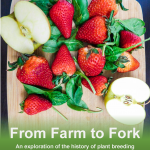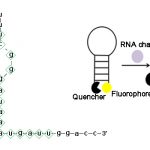An Electron Shuttle for Lignin Biosynthesis
Guo et al. uncover a unique electron donor protein for syringyl lignin biosynthesis in Arabidopsis thaliana. The Plant Cell (2019). https://doi.org/10.1105/tpc.18.00778
By Chang-Jun Liu
Background: Plants use sugar from photosynthesis as a carbon and energy source for their growth and development. When sugar breaks down, it releases the stored energy needed to drive a variety of biological processes, including synthesizing and depositing the biopolymer lignin in the cell wall. The released energy is delivered in the form of electrons via electron transport chains to fuel oxidative reactions. In the eukaryotic endomembrane, two electron delivery systems function in cytochrome P450-catalyzed reactions, which involve the electron donor proteins cytochrome P450 reductase (CPR), cytochrome b5 reductase, and cytochrome b5 (CB5). Three P450 enzymes are involved in the biosynthesis of lignin subunits; CPRs are regarded as typical electron donor protein for these P450s.
Question: We wanted to know if any other electron donors are involved in lignin biosynthesis and which electron transport chains are responsible for these P450-catalyzed reactions.
 Findings: We searched for proteins that physically associate with the three lignin biosynthetic P450s and examined Arabidopsis plants with loss of function of the recognized electron shuttle components. In addition to the CPRs, CB5 proteins were also pulled down with lignin biosynthetic P450s from the corresponding transgenic Arabidopsis plants. Knocking-out the gene encoding the CB5 protein CB5D specifically compromised the catalytic activity of ferulic acid 5-hydroxylase (F5H), one of the three P450 enzymes in the lignin biosynthetic pathway, which consequently impaired syringyl lignin deposition in the cell wall. By contrast, disrupting CPR led to the depletion of both guaiacyl and syringyl lignin subunits, the two major structural components of angiosperm lignin. These findings suggest that the electron donor activities of both CPR and CB5D are required for lignin synthesis but CB5D is specifically required for sustaining F5H activity and syringyl lignin biosynthesis.
Findings: We searched for proteins that physically associate with the three lignin biosynthetic P450s and examined Arabidopsis plants with loss of function of the recognized electron shuttle components. In addition to the CPRs, CB5 proteins were also pulled down with lignin biosynthetic P450s from the corresponding transgenic Arabidopsis plants. Knocking-out the gene encoding the CB5 protein CB5D specifically compromised the catalytic activity of ferulic acid 5-hydroxylase (F5H), one of the three P450 enzymes in the lignin biosynthetic pathway, which consequently impaired syringyl lignin deposition in the cell wall. By contrast, disrupting CPR led to the depletion of both guaiacyl and syringyl lignin subunits, the two major structural components of angiosperm lignin. These findings suggest that the electron donor activities of both CPR and CB5D are required for lignin synthesis but CB5D is specifically required for sustaining F5H activity and syringyl lignin biosynthesis.
Next steps: Lignin is an energy-dense biopolymer that can be used as a raw material for biological-based chemical production, but it poses a major obstacle to cell wall digestion for biofuel production. Flowering plants have several CB5 family members. Distinguishing their roles in different metabolic processes will facilitate the engineering of lignin structure and the redirection of energy flow to the desired metabolites.
Mingyue Gou, Xiaoman Yang, Yunjun Zhao, Xiuzhi Ran, Yanzhai Song, and Chang-Jun Liu (2019) Cytochrome b5 is an Obligate Electron Shuttle Protein for Syringyl Lignin Biosynthesis in Arabidopsis. https://doi.org/10.1105/tpc.18.00778.




